If you’re a woman who rides, you already know that a good motorcycle jacket is more than just a piece of gear. It plays a vital role in your safety on the road, affects how comfortable you feel during long rides and influences your overall riding experience. That’s why learning how to choose a motorcycle jacket for women is so important. It helps you find the right balance of protection, fit and style for every ride.
According to the Motorcycle Industry Council, nearly 20% of motorcycle owners are now women. This is quite a significant portion of the rider community, highlighting the importance of creating gear that caters specifically to female riders more than ever before. With the growing number of options available, it can be easy to feel overwhelmed, especially for beginners. That’s where this guide comes in.
Keep reading to learn everything you need to know about choosing the perfect motorcycle jacket for women.

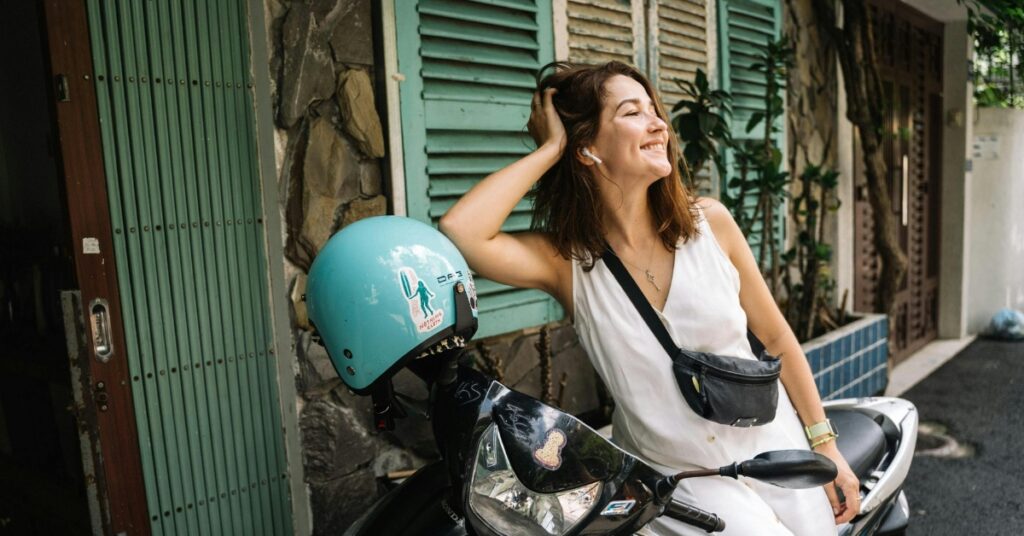
How to Choose a Motorcycle Jacket for Women: Why the Right Fit Matters
Finding a well-fitting motorcycle jacket is not just a matter of comfort – it is a critical factor in both safety and overall riding performance. How to choose a motorcycle jacket for women becomes quite important, especially as female riders have proportions that often differ from standard unisex sizing. Here are a specific points as to why the right fit matters.
Anatomy Fit Impacts Protection
Women’s motorcycle jackets are designed to accommodate unique anatomical considerations such as narrower shoulders, a more contoured waist and different bust-to-hip ratios. A jacket that follows these proportions ensures that built-in armour at the elbows, shoulders and back stays correctly aligned with the body. Misalignment can reduce the effectiveness of impact protection and increase the risk of injury in the event of an accident. From personal experience, if you are petite (like me) and/or quite curvy, nothing unisex fits right on us. You would be better off looking at the children’s section!
Comfort Enhances Focus and Endurance
Fit also directly impacts how focused and alert a rider can remain during long rides. Jackets that ride up, pinch or bunch at the joints create discomfort and distraction. Over time, poor fit can lead to tension in the neck, shoulders or lower back, making long-distance riding more physically taxing. A well-fitted jacket supports natural posture and movement, reducing the chances of strain and improving overall endurance.
Proper Fit Prevents Gear Fatigue
When a jacket doesn’t feel right, riders are more likely to adjust it repeatedly or avoid wearing it altogether – leading to inconsistent use of safety gear. A motorcycle jacket that fits well encourages consistent wear and ensures that all safety components function as intended every time a rider is on the road.
Style and Safety are Not Mutually Exclusive
Although safety is always top priority, many of us ladies (including myself!) still want to look good. A lot of motorcycle jackets, especially ones labelled “unisex” are boxy, unflattering and come in odd colours many of us would never wear like royal blue and highlighter yellow. Fortunately, modern manufacturers are slowly hearing us. We are starting to get a range of women’s motorcycle jackets that not only provide optimal protection, but also reflect a rider’s personal style. After all, if you like the way it looks, you are more likely to wear it!
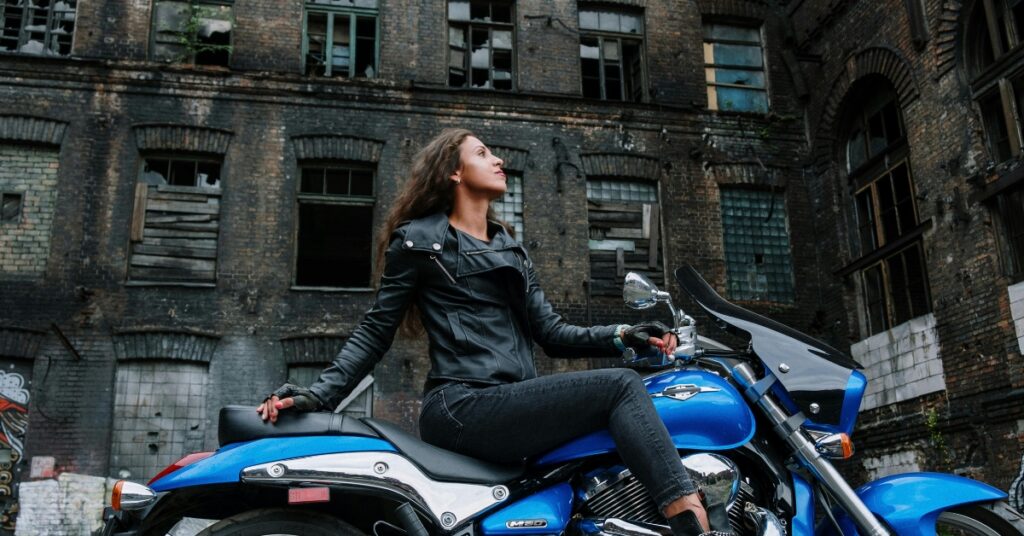
Essential Features in a Women’s Motorcycle Jacket
Now that we know why fit is so important, when considering how to choose a motorcycle jacket for women, there are a few key features to note.
Protection
Motorcycle jackets are designed to cushion your torso in the event of a crash, thereby making protection a first priority. Consider the following features specifically with protection in mind:
- CE-rated armour: Look for jackets that come with CE Level 1 or Level 2 armour. This armour should be placed in key areas such as the elbows, shoulders and, ideally, the back. The higher the sturdiness of the jacket, the more resilient it is to impact.
- Abrasion resistance: High-quality materials like leather, Cordura and Kevlar-reinforced textiles provide high abrasion resistance. This is essential for minimising road rash in an accident.
- Stitching and seams: Jackets with double or triple-stitched seams offer better durability, especially in the areas that are most likely to experience wear and tear during a fall.
- Back protector: Don’t forget your back! Some jackets have an optional back protector or pocket for an additional back insert. This is crucial for reducing the impact on your spine in case of an accident. We are not guaranteed to fall on our front, after all!
Fit and Sizing
The fit of your jacket plays a massive role in comfort and protection. A poorly fitting jacket won’t offer adequate protection in a crash and can make riding uncomfortable.
- Tailored for women: Choose a jacket that is specifically designed for women – not unisex, men’s or children. (For us petite ladies, how often have we been in the children’s section to find something that fits? Too often for me!). These jackets don’t consider a woman’s curves or narrower shoulders, which could result in shifting armour and discomfort.
- Adjustable elements: Look for jackets with adjustable waists, stretch panels and articulated sleeves. These features help the jacket conform to your body’s unique shape, providing freedom of movement while keeping it snug and in place during your ride.
- Base layer testing: When trying on jackets, wear the base layers you’d normally ride in, such as a t-shirt or riding shirt. Make sure the jacket doesn’t ride up when you reach forward or bend your arms.
Weather and Ventilation
Whether you’re riding in the heat of summer or the chill of winter, weatherproofing and ventilation are essential for comfort.
- Multi-season jackets: Things can get hot in there! If you plan on riding in different seasons, look for jackets with zip-out liners or removable thermal layers. These allow you to adjust for both cold weather and warmer conditions.
- Ventilation options: Ventilated jackets with mesh panels or zippered vents are ideal for hot summer rides. These features ensure airflow, helping to keep you cool even on the hottest days.
- Water-proofing: Look for jackets with waterproof membranes like GORE-TEX or D-Dry, which help keep you dry in rainy conditions while remaining breathable.
- Wind-proofing: For cold weather, a jacket with a windproof layer will protect you from chills, especially on longer rides at high speeds. Having a crispy cold neck is enough!
Visibility
Visibility is key to staying safe on the road, especially in low-light conditions or at night. How many of you have been surprised by a motorcycle appearing out of thin air when driving a car? I sure have!
- Reflective elements: Look for jackets with reflective panels, piping or high-visibility stitching. These will make you more noticeable to other drivers, which is particularly important when riding in the dark, or during the murky hours of dusk and dawn.
- Colour choices: I am not a fan of artificial colours, but they do stand out. Neon green or yellow are a good option for riders who spend a lot of time in low-light conditions.
Storage
Convenience is another factor that can make your ride more enjoyable. A jacket with functional storage will allow you to keep important items with you on the go.
- Pockets: Look for jackets with enough pockets to hold keys, a phone, wallet or other small personal items. I tend to bring a small bag, but a lot of the times I can’t be bothered locking and unlocking the tail box on my boyfriend’s bike. Best to tuck these items in somewhere.
- Zippered interior pockets: Interestingly, I rarely use these pockets as my jackets all tend to be quite snug. Nonetheless, there is nothing safer to store your valuables in.
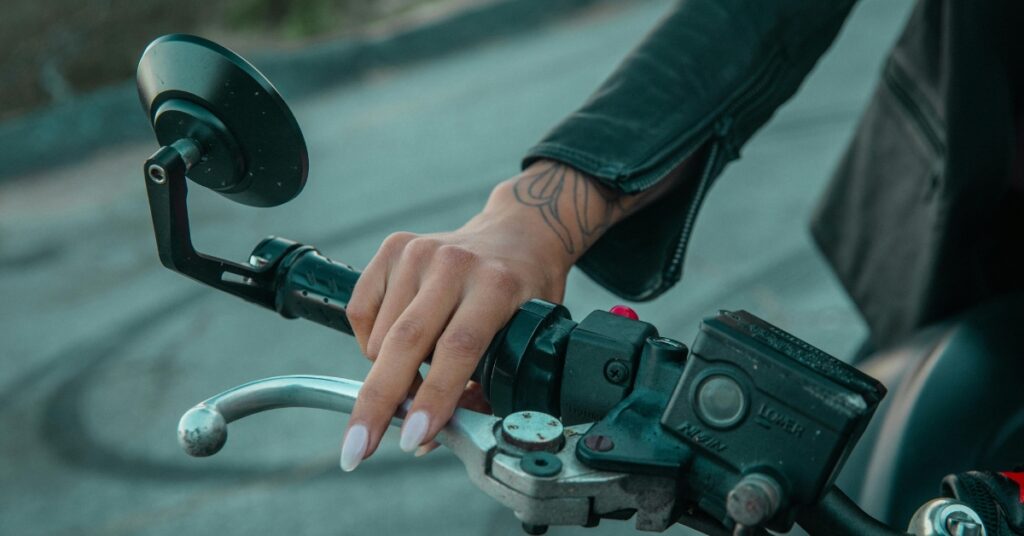
Leather vs. Textile: Choosing the Right Women’s Motorcycle Jacket Material
Now that we have the key features down pat, the next step in learning how to choose a motorcycle jacket for women is selecting the right material. Motorcycle jackets essentially come in either leather or textile. Each material has its own strengths, and understanding these differences can help in making an informed decision based on your riding style, climate and personal preference.
Leather
Leather is a classic choice, widely respected for its excellent abrasion resistance and long-term durability. High-quality leather – typically cowhide or kangaroo – is dense, protective and naturally resistant to tearing in the even of a slide.
Advantages
- Superior abrasion resistance in crash scenarios
- Timeless aesthetic, often preferred by cruiser and cafe-style riders (like me!)
- Molds to your body over time, improving comfort with use
Drawbacks
- Heavier and less breathable than textile
- Performs poorly in wet conditions unless treated (think leather shoes in the rain)
- Requires regular conditioning and care to maintain flexibility and longevity
Leather jackets are best suited for dry, moderate climates or short-distance, high-speed riding where protection is a top priority.
Textile
Although not as icon as leather, textile jackets have advanced considerably, often incorporating high-strength materials like Cordura, Kevlar or ballistic nylon. These synthetic fibres offer excellent versatility for riders who prioritise multi-season comfort and functionality.
Advantages
- Lightweight and generally more breathable
- Often water-resistant or even waterproof, with built-in membranes such e.g. GORE-Tex, D-Dry
- Integrated ventilation systems for hot-weather riding
- Frequently include zip-out thermal liners for cold weather
Drawbacks
- Lower abrasion resistance compared to premium leather
- May degrade faster with extended exposure to UV or frequent washing
- Less form-fitting unless designed with stretch panels or tailored construction
Textile jackets are preferred for multi-day touring, commuting and riding in variable or extreme weather conditions.
Leather/Textile Hybrids
Interestingly, some manufacturers now offer hybrid jackets that combine leather and textile elements to leverage the benefits of both. For example, leather is used on high-impact zones (like shoulders and elbows), while textiles are incorporated into the torso and underarms for breathability and weight reduction. This can be a good option for riders who want both robust protection and climate adaptability without owning multiple jackets.

Design and Style Considerations for Women’s Motorcycle Jackets
A well-designed women’s motorcycle jacket should ideally combine protection and personal style. Aesthetics do not have to come at the cost of performance – modern designs now successfully integrate both form and function. Modern jacket designs for women include the following styles:
- Cafe racer jackets: Minimalist design, close fit, often leather – ideal for urban or street riders. Example: Ixon Cranky Lady Jacket
- Cruiser jackets: Relaxed fit with classic lines, typically in leather, preferred by V-twin riders. Example: First Manufacturing Holli Women’s Jacket
- Touring jackets: Feature-rich textile with ventilation, liners and multiple storage pockets. Example: Klim Altitude Women’s Jacket
- Adventure jackets: Technical jackets for dual-sport or long-distance riding or varied terrain. Example: Alpinestars Stella Andes V3 Drystar Jacket
Reputable brands include brands such as Rev’It, Dainese and Alpinestars. They offer extended sizing ranges and cuts for petite, tall and plus-size riders – ensuring that every rider has access to gear that fits well and performs reliably.
Disclaimer: Please note that the jackets shown have no affiliate links – they are just styles I liked to showcase as examples. If we ever have affiliate links, we will inform our readers immediately.
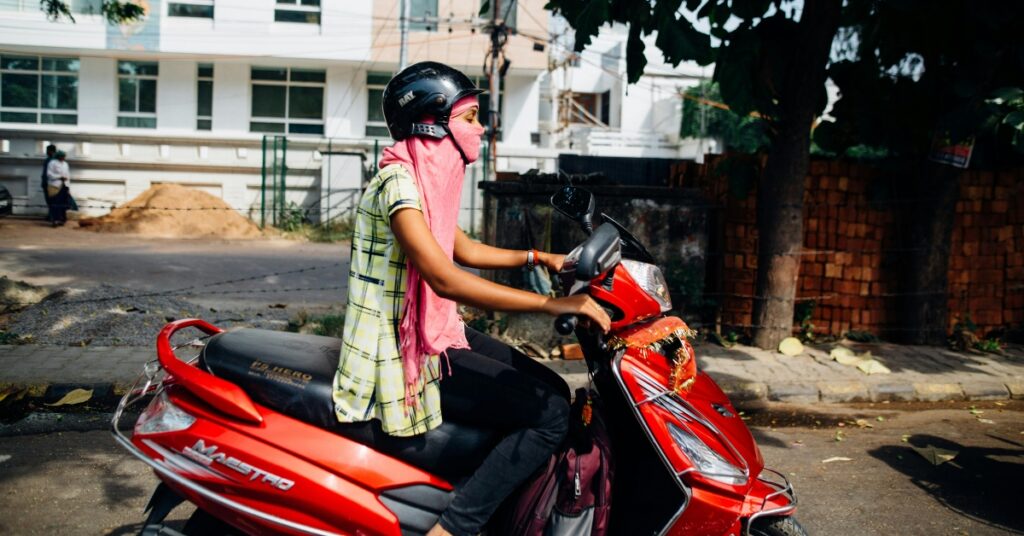
How to Choose a Women’s Motorcycle Jacket with Modern Safety Standards
When learning how to choose a motorcycle jacket for women, understanding the technical safety standards is crucial. After all, motorcycle jackets are more than just protective shells – they are engineered systems designed to absorb impact, resist abrasion and remain intact under stress. To ensure you are investing in quality gear that can perform in a crash scenario, it is important to consider the following safety certifications and features:
Understanding CE Ratings for Impact Protection
The CE (stands for Conformité Européenne) certification is a standardising testing protocol used to evaluate the impact protection offered by motorcycle armour.
- CE Level 1 Armour: Offers a basic level of impact protection. It allows for a higher transmitted force during testing, which means it absorbs less energy. CE Level 1 is often found in casual or entry-level jackets and is suitable for city riding or lower-speed commuting.
- CE Level 2 Armour: Provides a higher level of protection by limiting transmitted force to a greater degree. It is ideal for riders engaging in highway travel, touring or those who want an additional margin of safety. Jackets with CE level 2 armour offer enhanced impact resistance in critical zones like the shoulders, elbows and backs.
Always check if the jacket includes CE-certified armour or merely has “armour pockets”. Some jackets are sold without actual pads, requiring separate purchases to meet safety standards. I would say it is best to buy it once and buy it right, without fluffing around with in-between or nearly-there products.
EN 17092: The European Standard for Garment Abrasion Resistance
While CE certification applies to individual protectors, the EN 17092 standard assesses the entire garment’s structural integrity. It classifies motorcycle jackets based on their performance in abrasion, tear and seam strength tests.
There are five classes under EN 17092:
- AAA – Highest level of protection, typically used in professional or race-grade gear
- AA – Excellent protection, suitable for road and touring use
- A – Basic protection for urban riding or casual wear
- B – Jackets that offer abrasion resistance but no impact protection
- C – Designed to be worn over armour or other protective systems but not suitable as standalone protection
As a fairly regular rider (ok, passenger), I would recommend aim for at least an AA rating. This ensures that the outer shell can withstand high-speed slides and remain intact during impact events. Why risk your body with something inferior, even as an occasional rider?
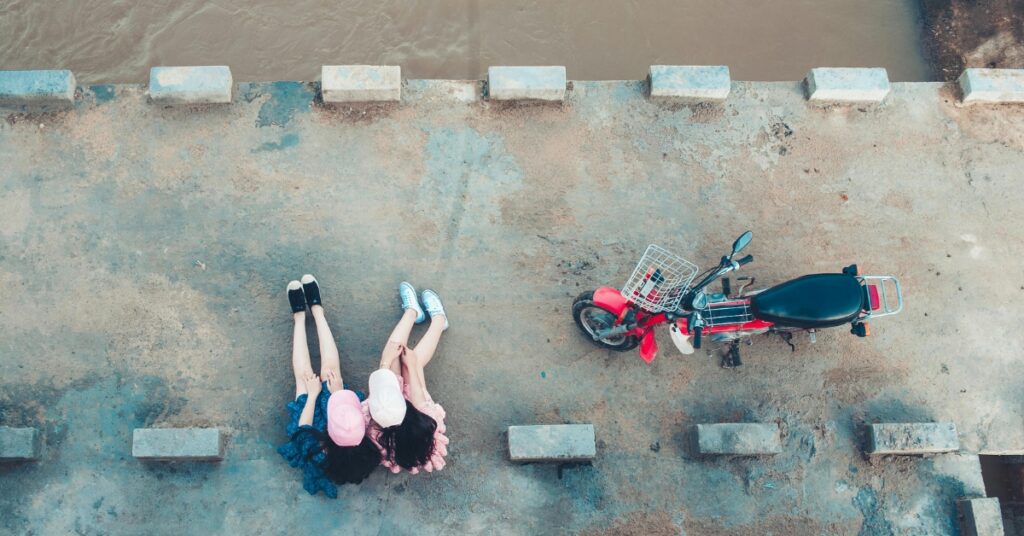
FAQ: Choosing A Motorcycle Jacket for Women
Q. How much should I spend on a women’s motorcycle jacket?
The price of a women’s motorcycle jacket can vary widely based on materials, protection level and brand reputation. Entry-level textile jackets with basic CE Level 1 armour typically start around $150-$250. Mid-range options with CE Level 2 protection and weatherproofing range between $300-$500. Premium leather jackets or multi-season touring gear with advanced safety ratings can cost $600 or more. When looking to purchase a jacket, consider your riding style and frequency as to what you realistically need from a jacket, but also make sure to buy the best quality you can afford.
Q. Do I need more than one motorcycle jacket?
Many riders benefit from having more than one jacket, especially if they ride year-round or in varying climates. A mesh or ventilated textile jacket is ideal for summer, while insulated or waterproof options provide protection in cold or wet weather. Some jackets also offer modular features like removable liners or zip-out membranes. I have personally gotten by quite fine with just one, but if you ride frequently, owning multiple purpose-built jackets makes sense.
Q. What is the best way to ensure a proper fit when buying online?
I would always recommend buying in person and being fitted by a professional. Unfortunately, I do understand that not all of us have that opportunity depending on access and availability of stores. Make sure to check the brand’s sizing chart carefully and don’t skip on taking your own measurements (i.e. bust, waist, hip and arm length). Read customer reviews for insights on fit – many women’s jackets run small or have limited adjustability. Always make sure the brand has a generous return policy, especially if you have never bought from them before. When trying on at home, test the jacket in your riding position to ensure it feels snug but not tight, does not ride up or restrict movement and has the armour properly aligned.
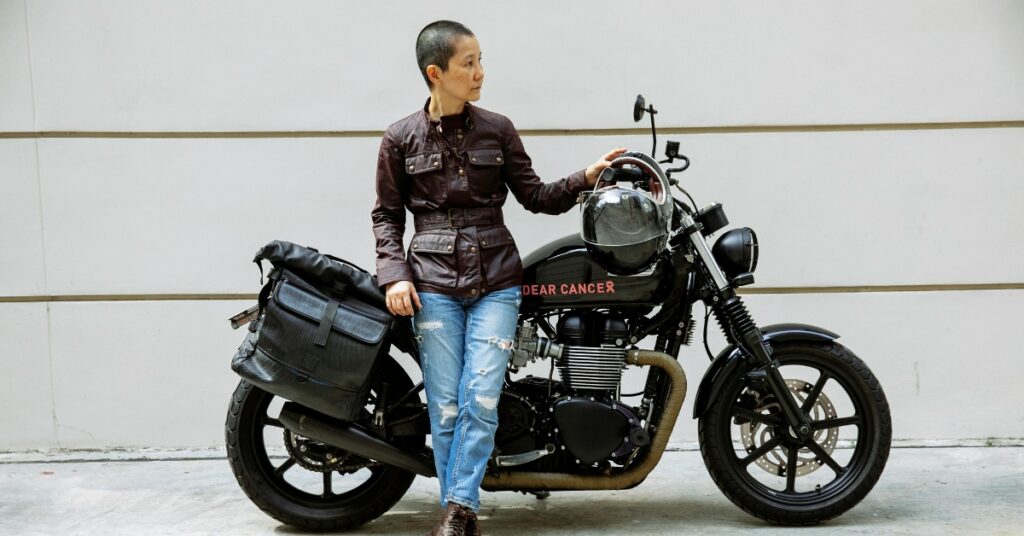
Final Thoughts
Learning how to choose a motorcycle jacket for women involves much more than picking a design you like. We need to consider the right materials, know the current safety standards and choose a style that reflects your specific needs – weather, terrain and riding style. In addition to a high quality helmet, your jacket is the next most important purchase you make regarding your personal protection. While aesthetics are important, safety should always take priority. Make sure to invest in the best quality jacket within your budget, as a well-chosen jacket doesn’t just look good – it performs when it matters most!





